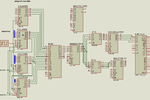vead
Full Member level 5

hello,
I need help to understanding following verilog code for PC
I understand how UP counter work but I don't understand how does PC work with different input ( example jump, branch )
?
I need help to understanding following verilog code for PC
Code Verilog - [expand]
I understand how UP counter work but I don't understand how does PC work with different input ( example jump, branch )
?



